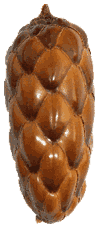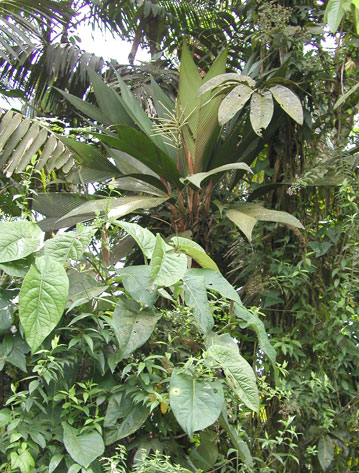 |
Palm |
 |
Palm |
Known only from the understory of the Cerro La Chapa cloud forest, in the northern Coastal Cordillera, state of Yaracuy, Venezuela; recently reported on the Cerro El Zapatero of the same state (Dr. Winfried Meier, pers. comm.), at 12001400 m.
Asterogyne yaracuyense is a solitary, unarmed, monoecious palm. The stems are erect or sometimes basally decumbent, 36 m tall x 58 cm diam., occasionally with basal and lateral vegetative branches. Leaves 1831, reddish brown when young, green when mature; sheath 1230 x 79 cm; petiole 1835 x 11.5 cm, blade 0.701.20 x 0.230.30 m, with a deeply bifid apex of ca. 42 cm; primary veins 40-70 per side. The inflorescence is interfoliar and branched to 1 order; peduncle 8595 cm long x 1.52 cm diam.; rachis 5-10 cm long x 0.5 cm diam.; rachillae 916, slightly pendent, glabrous; flower pits spirally arranged, covered with an inflexed lower lip, 2.53 x 2-5 mm. Flowers unisexual, white. The fruits are not known.
Aspects of its natural history are unknown.
 |
| Adult individual of Asterogyne yaracuyense in its natural habitat of Cerro La Chapa. Photo by F. W. Stauffer. |
Recent visits to the Cerro la Chapa, home of the largest population of the species, have confirmed the great alteration of the forest due to agricultural and cattle farming activities. A system of small plots in the cloud forest has been developed in order to promote the following activities:
As a consequence, there has been an uncontrollable alteration of the physiognomy and floristic diversity of the cloud forest. The present population of Asterogyne yaracuyense has been roughly estimated to be 200300 individuals, and the possibility for survival is low for the individuals that have managed to succeed in those very disturbed environments.
None
The taxonomic status of this species is well established, and no further morphological studies are apparently required in order to separate this species from the rest of the taxa within Asterogyne. The increasing threats mentioned above lend urgency to the need to carry out a thorough inventory of the populations in both Cerro La Chapa and Cerro Zapatero. The absence of current government regulation protecting the whole area makes of ex situ cultivation necessary to avoid the imminent extinction of the species. The reintroduction of the species may be the only way to regenerate the natural populations once the factors threatening the natural habitats are minimized.
Dr. Fred W. Stauffer, Conservatory and Botanic Gardens of Geneva, Switzerland